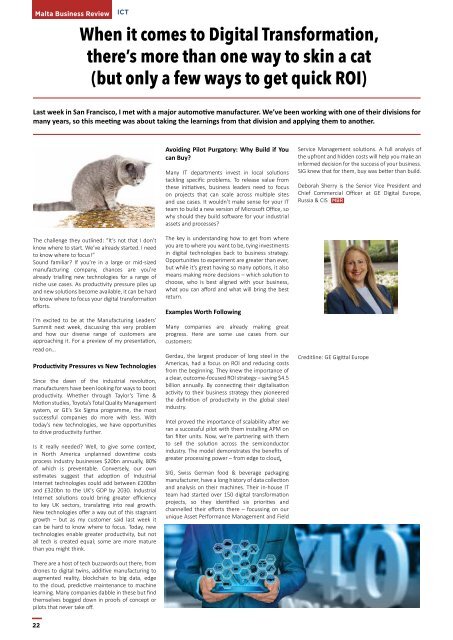MBR_ISSUE 46_NOV_DEC_18_LowRes
Create successful ePaper yourself
Turn your PDF publications into a flip-book with our unique Google optimized e-Paper software.
Malta Business Review<br />
ICT<br />
When it comes to Digital Transformation,<br />
there’s more than one way to skin a cat<br />
(but only a few ways to get quick ROI)<br />
Last week in San Francisco, I met with a major automotive manufacturer. We’ve been working with one of their divisions for<br />
many years, so this meeting was about taking the learnings from that division and applying them to another.<br />
The challenge they outlined: “It’s not that I don’t<br />
know where to start. We’ve already started. I need<br />
to know where to focus!”<br />
Sound familiar? If you’re in a large or mid-sized<br />
manufacturing company, chances are you’re<br />
already trialling new technologies for a range of<br />
niche use cases. As productivity pressure piles up<br />
and new solutions become available, it can be hard<br />
to know where to focus your digital transformation<br />
efforts.<br />
I’m excited to be at the Manufacturing Leaders’<br />
Summit next week, discussing this very problem<br />
and how our diverse range of customers are<br />
approaching it. For a preview of my presentation,<br />
read on…<br />
Productivity Pressures vs New Technologies<br />
Since the dawn of the industrial revolution,<br />
manufacturers have been looking for ways to boost<br />
productivity. Whether through Taylor’s Time &<br />
Motion studies, Toyota’s Total Quality Management<br />
system, or GE’s Six Sigma programme, the most<br />
successful companies do more with less. With<br />
today’s new technologies, we have opportunities<br />
to drive productivity further.<br />
Is it really needed? Well, to give some context,<br />
in North America unplanned downtime costs<br />
process industry businesses $20bn annually, 80%<br />
of which is preventable. Conversely, our own<br />
estimates suggest that adoption of Industrial<br />
Internet technologies could add between £200bn<br />
and £320bn to the UK's GDP by 2030. Industrial<br />
Internet solutions could bring greater efficiency<br />
to key UK sectors, translating into real growth.<br />
New technologies offer a way out of this stagnant<br />
growth – but as my customer said last week it<br />
can be hard to know where to focus. Today, new<br />
technologies enable greater productivity, but not<br />
all tech is created equal; some are more mature<br />
than you might think.<br />
There are a host of tech buzzwords out there, from<br />
drones to digital twins, additive manufacturing to<br />
augmented reality, blockchain to big data, edge<br />
to the cloud, predictive maintenance to machine<br />
learning. Many companies dabble in these but find<br />
themselves bogged down in proofs of concept or<br />
pilots that never take off.<br />
Avoiding Pilot Purgatory: Why Build if You<br />
can Buy?<br />
Many IT departments invest in local solutions<br />
tackling specific problems. To release value from<br />
these initiatives, business leaders need to focus<br />
on projects that can scale across multiple sites<br />
and use cases. It wouldn’t make sense for your IT<br />
team to build a new version of Microsoft Office, so<br />
why should they build software for your industrial<br />
assets and processes?<br />
The key is understanding how to get from where<br />
you are to where you want to be, tying investments<br />
in digital technologies back to business strategy.<br />
Opportunities to experiment are greater than ever,<br />
but while it’s great having so many options, it also<br />
means making more decisions – which solution to<br />
choose, who is best aligned with your business,<br />
what you can afford and what will bring the best<br />
return.<br />
Examples Worth Following<br />
Many companies are already making great<br />
progress. Here are some use cases from our<br />
customers:<br />
Gerdau, the largest producer of long steel in the<br />
Americas, had a focus on ROI and reducing costs<br />
from the beginning. They knew the importance of<br />
a clear, outcome-focused ROI strategy – saving $4.5<br />
billion annually. By connecting their digitalisation<br />
activity to their business strategy they pioneered<br />
the definition of productivity in the global steel<br />
industry.<br />
Intel proved the importance of scalability after we<br />
ran a successful pilot with them installing APM on<br />
fan filter units. Now, we’re partnering with them<br />
to sell the solution across the semiconductor<br />
industry. The model demonstrates the benefits of<br />
greater processing power – from edge to cloud.<br />
SIG, Swiss German food & beverage packaging<br />
manufacturer, have a long history of data collection<br />
and analysis on their machines. Their in-house IT<br />
team had started over 150 digital transformation<br />
projects, so they identified six priorities and<br />
channelled their efforts there – focussing on our<br />
unique Asset Performance Management and Field<br />
Service Management solutions. A full analysis of<br />
the upfront and hidden costs will help you make an<br />
informed decision for the success of your business.<br />
SIG knew that for them, buy was better than build.<br />
Deborah Sherry is the Senior Vice President and<br />
Chief Commercial Officer at GE Digital Europe,<br />
Russia & CIS <strong>MBR</strong><br />
Creditline: GE Gigittal Europe<br />
22
















